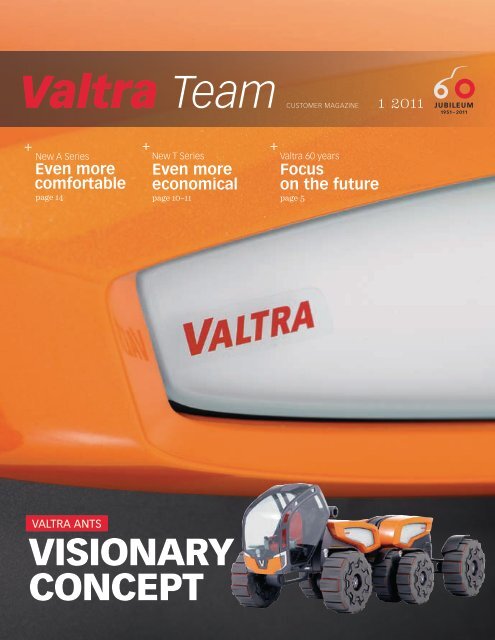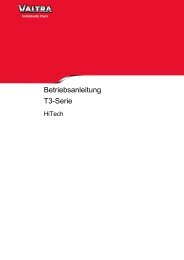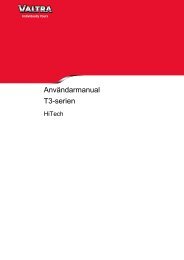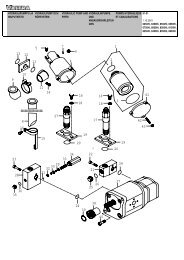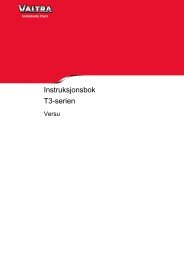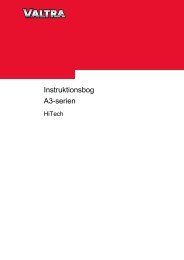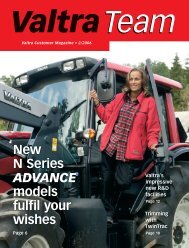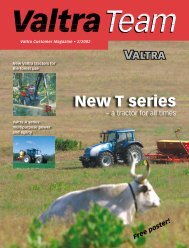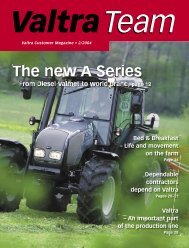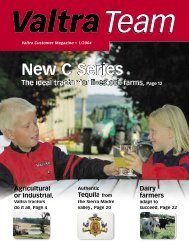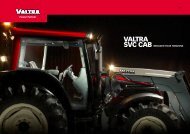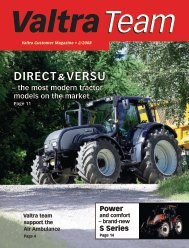You also want an ePaper? Increase the reach of your titles
YUMPU automatically turns print PDFs into web optimized ePapers that Google loves.
<strong>Valtra</strong> <strong>Team</strong><br />
new a series<br />
Even more<br />
comfortable<br />
page 14<br />
valtra ants<br />
new t series<br />
Even more<br />
economical<br />
page 10–11<br />
VISIONARY<br />
CONCEPT<br />
customer magazine <strong>1|2011</strong><br />
<strong>Valtra</strong> 60 years<br />
Focus<br />
on the future<br />
page 5
<strong>Valtra</strong> <strong>Team</strong><br />
eDItOrIal<br />
We’re off to a<br />
GOOD START<br />
2011 is valtra’s 60th anniversary<br />
and looks like being an exciting<br />
year. First the introduction of<br />
new models: First a series Hitech with<br />
a shuttle transmission, makes this popular<br />
tractor even more suitable for loader<br />
operation. remember, today shuttle<br />
transmissions and advanced tractor<br />
hydraulics make loader tractors a very<br />
competitive option. loader tractors depreciate<br />
more slowly than handlers, can<br />
be more reliable and without a telehandler<br />
on the farm, insurance costs drop.<br />
valtra were the first to introduce sCr<br />
technology into agriculture and we have<br />
now introduced this technology into t<br />
series. sCr is the injection of urea into<br />
exhaust gasses to reduce particulate<br />
and nOx emissions. sCr reduces cooling<br />
requirements and thus the time<br />
power sapping radiator fans operate. In<br />
s series, lab tests confirm a 5% to 10%<br />
reduction in fuel consumption compared<br />
with non sCr engines. In practice<br />
reports suggest our engines are even<br />
more frugal – we’ll let you know once<br />
we’ve collated verifiable figures.<br />
Finally I am left to welcome James<br />
Cullimore to our team as sales support<br />
specialist. the valtra team look forward<br />
to meeting you during our valtra test<br />
Drives. to book your test drive simply<br />
collect a form from your valtra dealer,<br />
at our stand at various shows or from<br />
our internet site www.valtra.co.uk fill<br />
in your details and return it.<br />
Mark Broom<br />
2 <strong>Valtra</strong> <strong>Team</strong> <strong>1|2011</strong><br />
06<br />
<strong>Valtra</strong><br />
customer<br />
magazine <strong>1|2011</strong><br />
IN THIS ISSUE:<br />
12<br />
ANTS responds to the challenges of the future<br />
while honouring <strong>Valtra</strong>'s traditions.<br />
03 arM – now with<br />
a colour display<br />
04 news<br />
06 valtra ants – future<br />
concept tractor<br />
09 60 years of valtra<br />
tractors from Finland<br />
10 new t series models<br />
– now even more<br />
economical<br />
12 valtra helps protect<br />
the landscape<br />
14 a series enters<br />
the Hitech era<br />
15 a reliable and<br />
cost-effective workhorse<br />
16 Young driver rates<br />
valtra driving experience<br />
18 a farming force<br />
in south West scotland<br />
19 valtra appoints sales<br />
support specialist for<br />
UK and Ireland<br />
20 a way back to work<br />
22 valtra Collection<br />
23 4WD bullseyes<br />
24 valtra models<br />
09<br />
20
ARM – Now with a colour display<br />
nigHt<br />
setting easY<br />
on tHe eYes<br />
JoYsticK<br />
controls<br />
Front anD rear<br />
HYDraulics<br />
arm gets a colour<br />
dISPlAY<br />
T<br />
series models with the new scr engines now come with a colour<br />
display on the driver’s armrest. the display has separate day and<br />
night settings. the daytime setting allows the information to be<br />
viewed even in bright sunlight, whereas at night the display is not too<br />
bright for the eyes.<br />
valtra’s patented arM armrest also has other new features. the<br />
joystick on the armrest can now be used to control the front or<br />
rear hydraulics, or both. the PtO and 4WD switches are now also<br />
on the armrest. In addition, it is now possible to make changes to<br />
programmes stored in the U-Pilot Headland Management system<br />
when the tractor is standing still. •<br />
BrigHt DaYtime<br />
setting<br />
New model<br />
suPerior<br />
suPPort oVer<br />
rougH terrain<br />
<strong>Valtra</strong> <strong>Team</strong> <strong>1|2011</strong> 3
new customer promise<br />
reinforces <strong>Valtra</strong>’s<br />
customer-based philosophy<br />
<strong>Valtra</strong> updated its customer promise and corporate identity in connection with its<br />
60 th anniversary in January.<br />
according to the company vision, valtra’s aim is to be the most desirable<br />
partner for individual and reliable tractors and solutions. the new customer promise<br />
“Individually Yours” communicates the company’s unique way of operating<br />
among its own employees, sales and service network, partners and above all customers.<br />
the core philosophy of valtra is to meet the individual needs of the customer.<br />
this philosophy is born from valtra’s unique customer-based service concept and<br />
customer order system, which was introduced in 1992. valtra’s sales representatives<br />
work in close partnership with their customers to determine the ideal tractor<br />
specifications for their requirements. the design of valtra tractors is based on<br />
modules combined with additional options and unique features, allowing half a million<br />
different combinations. this extreme versatility allows valtra to offer competitive<br />
solutions to customers involved in farming, forestry, municipal contracting and<br />
heavy contracting.<br />
the ongoing development of business practices, new investments in production,<br />
and future development plans will continue to reinforce valtra’s individual and customer-based<br />
operations.<br />
together with the customer promise valtra modernized its logo. the valtra name<br />
has appeared in 3D on the sides of tractors. the new print and electronic logo will<br />
have the same 3D design approach reflecting power and quality of its products. •<br />
Internet: valtra.com<br />
CUSTOmER mAgAzINE<br />
CElEbRATES 40 YEARS<br />
valtra’s customer magazine turns<br />
40 this year. the valtra tractor<br />
factory (then valmet) launched<br />
its first customer magazine in<br />
Finland in 1960 under the name<br />
“Maa ja Metalli” (“land and Metal”).<br />
the magazine appeared four<br />
times a year. although it looked<br />
quite different than today’s valtra<br />
team, the contents were very<br />
similar with articles about new<br />
tractor models, customer experiences,<br />
maintenance tips and production<br />
activities. Unlike today’s<br />
customer magazine, it also advertised<br />
valmet’s other products<br />
– everything from wall clocks to<br />
shotguns and outboard motors to<br />
water pumps.<br />
HITECH mOdElS NOw<br />
AVAIlAblE wITH 90 l/mIN<br />
HYdRAUlIC PUmP<br />
all t and n series Hitech models<br />
with the exception of the n82<br />
and n92 are now available with a<br />
90 l/min hydraulic pump. In addition,<br />
one of the hydraulic blocks<br />
is equipped with a flow adjustment<br />
valve. the new hydraulics<br />
have been designed on the basis<br />
of customer wishes. Customers<br />
can still specify the 73 l/min hydraulic<br />
pump.<br />
<strong>Valtra</strong> <strong>Team</strong><br />
Editor in chief Hannele Kinnunen, valtra Inc., hannele.kinnunen@valtra.com Edition tommi Pitenius, valtra Inc., tommi.pitenius@valtra.com<br />
Editorial Magdalena Kononowicz, aGCO sp. z.o.o., magdalena.kononowicz@valtra.com // Carlos villasante, aGCO Iberia, s.a.,<br />
carlosvillasante@mad.agcocorp.com // sylvain Mislanghe, aGCO Dist. sas, sylvainmislanghe@fr.agcocorp.com // lucy Jones, agco ltd.,<br />
lucyjones@uk.agcocorp.com // Kim Pedersen, lMB Danmark a/s, kim.pedersen@lantmannen.com // astrid Zollikofer, valtra vertriebs GmbH,<br />
astrid.zollikofer@valtra.com Publisher valtra Oy ab, valmetinkatu 2, 44200 suolahti<br />
Coordination Medita Communication Oy layout Juha Puikkonen, Innotyöverkko Osuuskunta<br />
valtra is a worldwide brand of aGCO<br />
Printed by Forssa Print 2010 Photos valtra archive if not otherwise mentioned<br />
4 <strong>Valtra</strong> <strong>Team</strong> <strong>1|2011</strong>
CalenDar<br />
The European Tractor<br />
Pulling Championships<br />
will be held in Alahärmä,<br />
Finland on 3–4 September<br />
2011. The <strong>Valtra</strong> Shell Pulling <strong>Team</strong> will be<br />
defending its title in the Pro Stock category.<br />
pulling.valtra.com<br />
Read more: valtra60.com<br />
The revolutionary ANTS concept tractor<br />
was lowered from the ceiling, astonishing<br />
guests at the evening gala.<br />
<strong>Valtra</strong> celebrates 60 years<br />
A peak into the future<br />
<strong>Valtra</strong> celebrated its 60 th birthday<br />
on 26 January 2011 at the<br />
Jyväskylä Paviljonki International<br />
Congress and trade Fair Centre. the<br />
focus of the celebrations was very<br />
much on the future. although classic<br />
tractors were on display, the main topic<br />
was valtra’s 120 th birthday in 2071.<br />
the event began with the Future<br />
seminar, in which futurologists David<br />
Smith, Sirkka Heinonen and Ray<br />
Hammond and valtra’s own Kimmo<br />
Wihinen, Pekka Ingalsuo and Luis<br />
Teles presented their views on life and<br />
agriculture in the coming decades.<br />
all of the speakers were of the same<br />
opinion that the demand for agricultur-<br />
The Agritechnica fair<br />
will take place in Hannover,<br />
Germany on 13–19 November<br />
2011. Agritechnica is the<br />
largest agricultural fair in the world, attracting<br />
around 350,000 visitors each year.<br />
agritechnica.com<br />
al products would increase significantly<br />
due to the growing population and quality<br />
of life, as well as the use of fields for<br />
energy production.<br />
at the 450-person evening gala,<br />
Martin Richenhagen recalled his cooperation<br />
with valtra before he became<br />
CeO of aGCO. He also set tough growth<br />
targets for valtra: through investments<br />
valtra should grow to become aGCO’s<br />
biggest tractor brand.<br />
the evening was crowned by a presentation<br />
of the revolutionary ants concept<br />
tractor. You can read more about<br />
ants elsewhere in this issue. On the<br />
following day, members of the press<br />
were treated to a tour of the suolahti<br />
The <strong>Valtra</strong> do brasil<br />
celebrated its 50th<br />
anniversary in Mogi das<br />
Cruzes in Brazil. The factory<br />
had a good year in 2010, producing<br />
14,740 tractors.<br />
valtra.com.br<br />
News international<br />
The new A and T Series were presented<br />
to 150 international journalists<br />
at the Suolahti factory.<br />
factory, including presentations of the<br />
new t3 and a3 Hitech models.<br />
valtra’s 60 th anniversary celebrations<br />
culminated the next day with a special<br />
staff party, which was attended by 1350<br />
employees and their partners. •<br />
<strong>Valtra</strong> <strong>Team</strong> <strong>1|2011</strong> 5
coNcepT // <strong>Valtra</strong> ANTS<br />
TExT tOMMI PItenIUs PHOTOS valtra<br />
<strong>Valtra</strong> ants<br />
fUTURE<br />
CONCEPT TRACTOR<br />
the farmers and contractors of the future will need versatile, lightweight and<br />
powerful machines that allow them to work more diversely and efficiently than<br />
with traditional tractors. ants meets the challenges of the future while at the<br />
same time respecting valtra’s traditions. It is dynamic, friendly, customisable,<br />
smart and agile, and it has an excellent power to weight ratio.<br />
6 <strong>Valtra</strong> <strong>Team</strong> <strong>1|2011</strong><br />
The name ANTS is a play on words.<br />
It refers to <strong>Valtra</strong>’s current model<br />
series – A, N, T and S – but also<br />
to the insect. Ants are considered<br />
to be extremely strong and social<br />
insects, and the ANTS concept reflects the<br />
hardworking characteristics of real ants.
The user interface for the driver has been designed to be as simple<br />
as possible and can react to voice commands and different<br />
kind of gestures. The remaining functions are controlled from<br />
the intelligent armrest, so there are no normal screens to block<br />
visibility. Instead, the information is displayed on the glass surfaces<br />
of the cab in the form of a head’s-up display (HUD). ANTS<br />
can communicate with other machines, farm computers, weather<br />
forecasts, navigation systems and the internet. The cab is also<br />
extremely quiet thanks to the electronic transmission.<br />
The ANTS loader combines features of traditional front loaders,<br />
tele-handlers and forest machines. The loader consists<br />
of dual beams that are attached to the same pivot point at<br />
the cab. This way the loader can turn together with the cab<br />
allowing for full visibility and control. Both loader beams can<br />
be controlled individually. For further reach the ANTS front<br />
loader is equipped with an inbuilt telescopic boom.<br />
When not in use the loader can be folded to the<br />
back of the cab.<br />
<strong>Valtra</strong> ANTS consists of two modules: a soldier unit with an<br />
output of 100 kW and a worker unit with an output of 200 kW.<br />
If required the modules can be combined, creating an ANTS<br />
queen with three axles, eight wheels and an output of 200,<br />
300 or 400 kW. While ANTS can perform routine field jobs independently,<br />
a driver is still needed for more complex tasks such<br />
as front-loading work. This is why both ANTS units can be also<br />
equipped with a cab.<br />
Intelligent wheels ensure maximum grip in all conditions. The<br />
wheels can be widened to up to twice their standard width.<br />
The tyre pattern can also be adjusted for a shallow or deep tread.<br />
The width, softness and patterns of the tyres can be adjusted<br />
by the driver or automatically.<br />
<strong>Valtra</strong> <strong>Team</strong> <strong>1|2011</strong> 7
coNcepT // <strong>Valtra</strong> ANTS<br />
Each of the ANTS wheels is connected to the chassis<br />
via a suspension beam. The stiffness and position of<br />
the beams can be individually adjusted. The tractor<br />
stays level on all terrains. The height of the tractor can<br />
be adjusted to different work environments. When expanded<br />
to maximum height ANTS can easily avoid obstacles,<br />
such as when harvesting forage, planting root<br />
vegetables or working in the forest. During transport at<br />
high speeds the body of the tractor can be lowered to<br />
increase stability and aerodynamics. In tight buildings,<br />
gateways and doorways the tractor can kneel down to<br />
pass under the obstruction.<br />
Each ANTS module has a spinal<br />
core along which the cab and<br />
implements can be attached. The<br />
rail-like spine runs across the<br />
whole module so that implements<br />
can be attached on either<br />
end of the tractor or in the middle.<br />
<strong>Valtra</strong>’s traditional TwinTrac feature has<br />
been taken to the limit, as ANTS has no front or<br />
rear. There is no need for traditional 3-point linkages,<br />
but it is still possible to attach traditional implements<br />
to the spinal core using an adaptor. Most of<br />
the implements are controlled by electric motors. If<br />
traditional hydraulics are required, they run on water.<br />
An electric motor is located in each of the wheels. The power<br />
sources can be changed according to availability. These include<br />
high-capacity batteries, fuel cells or internal combustion engines<br />
fuelled from the farm’s own biogas, biodiesel or ethanol.<br />
Additional operating capacity, for example in cold climates, is<br />
possible by adding external battery bags to the ANTS modules.<br />
8 <strong>Valtra</strong> <strong>Team</strong> <strong>1|2011</strong><br />
farms in the future will<br />
be at the heart of society<br />
In the year 2050 the world will be inhabited by 9 billion<br />
people, and up to 80 percent of all people will live<br />
in built-up areas and cities. the amount of arable farm<br />
land will be diminishing due to continued urbanisation,<br />
desertification and pollution. Our diets will remain<br />
much the same, but more meat will be consumed in the<br />
developing countries, which will put further pressure on<br />
arable farm land. the farmer of the future will be tasked<br />
with saving the world from famine, while also producing<br />
energy and managing waste.<br />
Farmers will need advanced technology to feed the<br />
growing population. automation will have made great<br />
strides both in arable farming and animal production,<br />
as well as in such areas as crop planning, irrigation,<br />
feeding, positioning and logistics. Farms will be divided<br />
into highly efficient and large-scale corporate farms<br />
and smaller family farms producing luxurious local<br />
food. Breeding, genetic engineering and plant<br />
protection have enabled increased production<br />
volumes and yields, while risks have been maintained<br />
at current levels despite more severe climate<br />
conditions. especially local and organic farms will process<br />
more food themselves.<br />
In addition to food, farms will provide energy.<br />
the biomass required for energy production can be<br />
obtained from the forest, fields or bogs. the biomass<br />
can be processed into wood chips, biogas, biodiesel,<br />
ethanol, straw, peat or other fuels. the end-products<br />
include electricity, district heating and fuel for vehicles.<br />
Farms will sell either fuel raw materials, processed fuels<br />
or finished products. In addition, wastelands will be<br />
used for wind and solar energy production.<br />
some of the farms will also serve as recycling centres.<br />
they will receive municipal biowaste that is then<br />
composted into compost or biogas. Combustible waste<br />
can be burned for energy together with the biomass<br />
produced by the farms.<br />
the farmer of the future will be a highly trained and<br />
respected professional who manages his or her own<br />
production plant. Demand for agricultural products will<br />
continue to exceed supply, and the real price of food<br />
will be several times what it is today. •
60 years of<br />
VAlTRA<br />
TRACTORS<br />
fROm fINlANd<br />
<strong>Valtra</strong>’s predecessor valmet began tractor production in<br />
Finland after the conclusion of the second World War. Having<br />
manufactured rifles, artillery pieces and aircraft engines,<br />
the company’s factories began producing agricultural tractors. the<br />
first valmet 15 tractors were manufactured in 1951.<br />
In 1960 valmet established a tractor plant in Mogi das Cruzes,<br />
Brazil. this bold and risky decision to open a factory on the other<br />
side of the world has since proven to be right: valtra do Brasil is<br />
today the second leg upon which the valtra brand stands.<br />
In 1979 valmet acquired the tractor operations of swedish company<br />
volvo BM. together with its own predecessors Bolinder and<br />
Munktell, volvo BM had deep roots in the industrial history of<br />
sweden. theofron Munktell opened his first workshop in eskilstuna<br />
in 1832. the co-designed volvo BM valmet 05 series was launched<br />
in 1982.<br />
the aGCO sisu Power engine plant in linnavuori, Finland is an<br />
integral part of valtra’s history. the valtra tractors manufactured<br />
in suolahti have all been powered by engines from aGCO sisu Power<br />
or its predecessors Sisu Diesel and Valmet. •<br />
hiSTory // <strong>Valtra</strong> 60 years<br />
TExT tOMMI PItenIUs PHOTOS valtra<br />
<strong>Valtra</strong> <strong>Team</strong> <strong>1|2011</strong> 9
TExT tOMMI PItenIUs PHOTOS valtra<br />
new t series models<br />
T Series scr-engine<br />
NOw EVEN mORE<br />
ECONOmICAl<br />
the largest models in the t series have been updated<br />
in accordance with the latest emissions regulations.<br />
the introduction of new engine technology has also been<br />
accompanied by numerous other improvements.<br />
At the heart of the new T183<br />
and T203 Direct models and<br />
the T183 and T213 models<br />
is AGCO Sisu Power’s<br />
7.4-litre SCR engine. Fuel<br />
consumption is 5 to 10 percent lower<br />
than similar engines without<br />
SCR technology. In addition, the<br />
SCR system reduces both cooling<br />
needs and emissions while<br />
keeping the lubrication oil<br />
cleaner. In other words, SCR<br />
technology saves both fuel<br />
and the environment.<br />
<strong>Valtra</strong> has years of<br />
experience with SCR<br />
technology. The <strong>Valtra</strong><br />
S Series introduced in<br />
2008 was the first agricultural<br />
tractor in the world to feature<br />
SCR technology. The additive<br />
Ad Blue has been used to reduce<br />
emissions in road transport for even<br />
longer. For tractor users SCR technology<br />
is simple, as electronics take<br />
care of the system. The driver’s only<br />
task is to fill the AdBlue tank in the<br />
same way as the fuel tank or the<br />
windshield washer fluid reservoir.<br />
The amount of Ad Blue consumption<br />
is 3 to 5 percent that of fuel consumption<br />
in engines that comply with<br />
Stage 3B emissions norms, i.e. slight-<br />
10 <strong>Valtra</strong> <strong>Team</strong> <strong>1|2011</strong><br />
The biggest T Series models now<br />
feature SCR technology, which reduces<br />
emissions and fuel consumption. Ad-<br />
Blue, a urea-water solution, is sprayed<br />
into the exhaust gases before the catalytic<br />
convertor, which is located in the exhaust<br />
pipe. The AdBlue reacts with the nitrogen<br />
oxide in the catalytic convertor, producing harmless<br />
compounds in the process. What comes out of<br />
the exhaust pipe is primarily nitrogen gas and water.<br />
As the SCR system takes care of emissions, the engine<br />
can be tuned optimally without compromises.
t series TechNicAL SpeciFicATioNS<br />
S T A n D A R D<br />
m A x kw/hp/nm<br />
b O O S T<br />
m A x kw/hp/nm<br />
dIRECT<br />
T183 138/188/770 148/202/820<br />
T203 150/204/800 158/215/850<br />
VERSU<br />
T183 138/188/770 148/202/820<br />
T213 158/215/850 166/225/900<br />
in addition to new engine technology,<br />
the 3rd generation T3 Series comes<br />
with many other new features.<br />
SCR technology has been used for years in S<br />
Series tractors and heavy vehicles. The onboard<br />
electronics operate the system, and all the driver<br />
has to do is fill the AdBlue tank in the same way<br />
as the fuel tank or windscreen wiper fluid reservoir.<br />
SCR technology reduces fuel consumption by<br />
5 to 10 percent and prolongs engine life.<br />
ly higher than in engines that comply with<br />
earlier standards.<br />
The new engines offer slightly more<br />
power and significantly more torque than<br />
before, and the nominal engine speed has<br />
been reduced to 2100 rpm. Sigma Power<br />
and Transport Boost have also been<br />
increased. The most powerful T Series<br />
model is now the T213, which produces<br />
15 more horsepower than previous models.<br />
The torque and power curves of both Versu<br />
and Direct models have been revised, and<br />
the engine now works even better with the<br />
power train. With the new software, both the<br />
stepless and powershift models provide optimal<br />
performance in all conditions.<br />
In addition to new engine technology, the 3rd<br />
generation T3 Series comes with many other new<br />
features. The patented <strong>Valtra</strong> ARM driver’s armrest<br />
now has a colour display with separate daytime and<br />
night settings. The joystick on the armrest can now<br />
be used to control the front or rear hydraulics, or both.<br />
The PTO and 4WD switches are now also on the armrest.<br />
In addition, it is now possible to make changes to<br />
programmes stored in the U-Pilot Headland Management<br />
System when the tractor is standing still.<br />
The new T Series is available with a new factoryfitted<br />
Auto-Steering readiness or the complete System<br />
150 Auto-Steering package, which can steer the tractor<br />
with an accuracy of just a few centimetres. The factory-fitted<br />
AGCOMMAND satellite navigation system is<br />
also available, allowing the location, current task, productivity<br />
and servicing requirements of the tractor to<br />
be monitored over the internet. •<br />
<strong>Valtra</strong> <strong>Team</strong> <strong>1|2011</strong> 11
USer // Rupert Hanbury-Tenison<br />
TExT ANd PHOTOS rOGer tHOMas<br />
<strong>Valtra</strong> helps protect<br />
T H E<br />
lANdSCAPE<br />
Changes in land use and management on Bodmin Moor including<br />
a reduction in grazing animals coupled to increases in ambient<br />
temperatures has, in certain areas, lead to what can almost be<br />
described as a monoculture of gorse.<br />
Not the native Western<br />
Heath Gorse but a strain<br />
resulting from hybridisation<br />
with European<br />
strains making it increasingly<br />
invasive and less acceptable<br />
as part of the moor’s ecosystem.<br />
Exacerbating the problem, as gorse<br />
areas expand so other plant spices,<br />
wildlife habitat, and grazing are lost<br />
and, although moorland grazing is<br />
not highly productive it is a useful<br />
resource.<br />
So, how to control the gorse?<br />
Traditional methods were mostly<br />
based around burning; an unacceptable<br />
method today as it directly releases<br />
CO2 into the atmosphere and<br />
destroys natural peat deposits. This<br />
is something of a double whammy<br />
as peat locks up carbon at around<br />
80 tonnes per hectare per year.<br />
Should the peat be inadvertently<br />
burnt along with gorse it will release<br />
around 120 tonnes of carbon<br />
per hectare. These factors were<br />
part of the problem taxing rupert<br />
hanbury-Tenison, a farmer on Bod-<br />
min Moor and partner in Moor Heat<br />
LLP., a company that undertakes<br />
tree, moorland and river maintenance.<br />
“An alternative method of gorse<br />
control was clearly required but it<br />
has to be ecologically and economically<br />
acceptable,” points out Rupert<br />
Hanbury-Tenison. “Many of the<br />
moor’s farmers are in HLS and<br />
UELS stewardship schemes so some<br />
cash is available but from my point<br />
of view we needed to find something<br />
that went that little bit further,<br />
something that made good management<br />
of the Moor’s environment acceptable<br />
without being a drain on<br />
resources.”<br />
One solution would be a system<br />
that allowed the cut gorse to be utilised<br />
elsewhere. There are some<br />
machines that cut gorse and similar<br />
materials and others that will bale,<br />
bundle really, woodland brash and<br />
similar material such as gorse; both<br />
systems require high powered machines<br />
consuming expensive fuel.<br />
Then Rupert came across the Bio-<br />
Systems require high powered<br />
machines consuming expensive fuel.<br />
12 <strong>Valtra</strong> <strong>Team</strong> <strong>1|2011</strong><br />
baler. “It looked just the machine we<br />
required,” he recalls. Manufactured<br />
in Canada the Biobaler can best<br />
be described as a heavy duty forest<br />
mulching machine connected to the<br />
front of a round baler on steroids; a<br />
machine that has the capacity to cut<br />
and bale a variety of woody materials<br />
up to five inches in diameter.<br />
Rupert and business partner<br />
robert Stirling formed Moor-Heat<br />
Ltd to purchase and operate the Biobaler.<br />
“The Biobaler requires 200 hp<br />
at the PTO and operates in pretty<br />
demanding conditions. We needed a<br />
tractor that would be reliable, stand<br />
up to the harsh operating conditions,<br />
provide a comfortable working<br />
environment and deliver the right<br />
amount of power at the PTO – economically.”<br />
Rupert had, for some time, been<br />
operating <strong>Valtra</strong> tractors; an 8150 for<br />
trailer haulage, winching and chipping<br />
and a smaller 705 with loader<br />
for a host of other operations. Both<br />
machines had proved reliable and<br />
easy to operate. Importantly, <strong>Valtra</strong>,<br />
and before them Valmet, machines<br />
are specifically designed to operate<br />
in demanding forestry conditions.<br />
“Many Scandinavian farms include<br />
areas of commercial forestry. Farm-
ers work in the fields during the<br />
summer and the woods during the<br />
winter; as a result the underside of<br />
<strong>Valtra</strong> tractors – the popular brand<br />
– is devoid of components that are<br />
easily damaged. It is also easy to<br />
fit forestry guarding to a <strong>Valtra</strong>.”<br />
Rupert explains. Moor-Heat purchased<br />
a used <strong>Valtra</strong> 8950 from Cornish<br />
dealer B&B Agricultural Sales<br />
of Doublebois near Liskeard. “We’d<br />
found they offered a first class service<br />
to match the tractor and our requirements.”<br />
While looking into the gorse<br />
problems other possible uses of the<br />
equipment had come to light. “The<br />
disease Phytopthora Ramorum, or<br />
Sudden Oak Death, is an increasing<br />
problem causing the potential<br />
decimation of thousands of hectares<br />
of commercial forestry and native<br />
woodland,” explains Rupert. The<br />
main host for this pathogen is the<br />
invasive Rhododendron Ponticum<br />
found throughout the forestry sector<br />
and across large estates in Cornwall<br />
and elsewhere. A large effort is being<br />
made to clear both infected and<br />
uninfected plants to prevent further<br />
spread of Phytopthora. Even though<br />
Bales of gorse weigh in at around 500 kg<br />
and are easily handled with a front loader.<br />
present rules that say rhododendron<br />
must not be moved but burnt on site,<br />
could infected and uninfected rhododendron<br />
be used as a biomass?<br />
Whatever the outcome of this challenge,<br />
the <strong>Valtra</strong> tractor and Biobaler<br />
combination is clearly an effective<br />
way of clearing Rhododendron from<br />
amongst standing timber with the<br />
Valmet 705 easily capable of moving<br />
the baled material to a safe area for<br />
burning.<br />
And what of other materials?<br />
Rupert has already used the <strong>Valtra</strong><br />
tractor and baler to harvest stands<br />
of blackthorn and willow. “Operating<br />
in conveniently worked areas a<br />
single driver should be able to clear<br />
around 1ha of gorse or rhododendron<br />
in a day depending on ground<br />
conditions. Working in stands of willow<br />
or other specifically grown biomass<br />
crops such as miscanthus even<br />
greater output can be expected.”<br />
What next? Thanks to the natural<br />
spring of the material within the<br />
bale it is less dense than a grass bale,<br />
a 4 ft x 4 ft bale weighs in at around<br />
500 kg and even very sappy material<br />
does not heat up. Left under cover<br />
baled rhododendron dries quickly;<br />
With a bar on the front linkage<br />
to push over tall plants the baler<br />
is capable of clearing material<br />
up to 5 feet.<br />
from 60 percent moisture to 30 percent<br />
in a couple of months although<br />
the exact length of time is dictated<br />
by the season in which the material<br />
was cut and baled. Dried, one bale<br />
of gorse contains energy potentially<br />
equivalent to a third of a barrel<br />
of crude oil or put another way it is<br />
capable of producing one megawatt<br />
hour of energy so Moor-Heat have<br />
a number of options. They can use<br />
bales to fuel a furnace, currently the<br />
business uses the heat to dry cut<br />
timber for sawing, logs or kindling.<br />
Alternatively, the baled material<br />
may be chipped for use in combined<br />
heat and power boilers or pressed<br />
into briquette, a much hotter heat<br />
source than natural logs.<br />
“With the ability to run the<br />
<strong>Valtra</strong> 8950 entirely on biofuel<br />
(<strong>Valtra</strong> were the first tractor manufacturer<br />
to use engines with this<br />
capability) the carbon footprint of<br />
Moor-Heat’s operation is potentially<br />
carbon neutral which has to be<br />
the best way of returning the Moor<br />
to a more diverse natural state with<br />
a range of flora, fauna and commercial<br />
use,” concludes Rupert<br />
Hanbury-Tenison. •<br />
<strong>Valtra</strong> <strong>Team</strong> <strong>1|2011</strong> 13
TechNoLogieS // A Series<br />
TExT tOMMI PItenIUs PHOTOS valtra<br />
a series enters the<br />
HITECH ERA<br />
The new electronic HiTech forward-reverse<br />
shuttle that is now<br />
available on the A Series is closely<br />
related to <strong>Valtra</strong>’s traditional shuttle<br />
feature, which is widely considered the<br />
best on the market. The smooth and<br />
precise shuttle is a big advantage when<br />
performing front-loader tasks. The system<br />
also features an integrated handbrake,<br />
further enhancing convenience<br />
and safety.<br />
Together with the electronic shuttle<br />
the A Series gets a dual-speed PTO<br />
controlled by a hydraulic multidisc<br />
clutch. The PTO is operated by simple<br />
switches, and the hydraulics offer<br />
smooth engagement. Control switches<br />
can also be optionally specified in the<br />
rear mudguard.<br />
The new A Series tractors are powered<br />
by AGCO Sisu Power 3.3-litre<br />
common rail engines. A viscous fan<br />
and common rail fuel injection reduce<br />
both noise and fuel consumption. With<br />
the introduction of electronic engine<br />
management, the A Series is now also<br />
available with cruise control.<br />
Other new electronic features are<br />
available for operating the front linkage<br />
and transmission. <strong>Valtra</strong>’s electronic<br />
Autocontrol front linkage is<br />
extremely precise, and switches for<br />
raising and lowering the linkage can<br />
14 <strong>Valtra</strong> <strong>Team</strong> <strong>1|2011</strong><br />
be found in both rear mudguards.<br />
<strong>Valtra</strong>’s unique Autotraction feature<br />
and automated 4WD system are ideal<br />
for tasks that require repeated stopping<br />
and starting. The options list also<br />
includes electronic Proline dials that<br />
provide a wide range of information.<br />
Driver comfort has been taken to a<br />
new level. Noise levels in the cab have<br />
been further reduced, and the cab itself<br />
has been comprehensively updated.<br />
The suspended pedals, including electronic<br />
clutch and gas pedals, are easy to<br />
operate even with heavy boots. Entering<br />
the cab is now easier thanks to wider<br />
access. The adjustability of the steering<br />
wheel and driver’s seat has also<br />
been improved. Customers no longer<br />
need to specify a forest cab, as the redesigned<br />
cab offers a more even floor. For<br />
forest tasks the cab can be specified<br />
with a gas pedal in the rear and a rear<br />
window designed for a loader valve. •<br />
A Series tractors equipped with the forwardreverse<br />
shuttle are available as HiTech models.<br />
The traditional A Series tractors are also<br />
available as A72, A82 and A92 Classic models.<br />
a series hiTech<br />
m A x kw/hp/nm<br />
a83 65/88/325<br />
a93 75/101/370<br />
The <strong>Valtra</strong> A Series has traditionally<br />
been the most popular tractor<br />
in Scandinavia. <strong>Valtra</strong> has further<br />
improved the forest features that<br />
are so important in this region.
a reliable and cost-effective<br />
wORkHORSE<br />
When henry Tomlinson’s<br />
tractor let him down back<br />
in 2003 he turned to his<br />
local <strong>Valtra</strong> dealer, David Eaton<br />
Tractors Ltd. of Fradswell, Staffordshire.<br />
David let him borrow his<br />
8050 demonstration tractor and<br />
the rest, as they say is history.<br />
Henry Tomlinson farms just<br />
over 180 acres just to the north of<br />
Lichfield. The crop rotation is simple:<br />
one year rape followed by two<br />
of wheat. Alongside his farming<br />
activities Henry offers a contracting<br />
service: ploughing and cultivating,<br />
silage hauling – he has his own<br />
14 tonne trailer – and round baling<br />
of hay, silage and straw – Henry<br />
produces over 3600 straw bales<br />
every year.<br />
“In the cab of that 8050 I was<br />
really happy, for its day it was a<br />
really nice drive.” In the four years<br />
the 8050 was on the farm Henry<br />
learned <strong>Valtra</strong> have many important<br />
advantages. “The engine has<br />
bags of torque, they pull their<br />
hearts out for you and don’t use<br />
much fuel doing it. It gave absolutely<br />
no trouble. I also found baling<br />
after big combines was much easier<br />
– ground clearance is excellent<br />
and there’s nothing underneath for<br />
straw to get hung up on – even the<br />
drive shaft to the front axle is well<br />
guarded.”<br />
In July 2007 Henry decided it<br />
was time for a change and returned<br />
to David Eaton Tractors to catch<br />
up on latest developments from<br />
<strong>Valtra</strong>. “They had a T150 HiTech<br />
demonstration tractor at the time.<br />
I gave it a try and finished up buying<br />
it – and I got more for the 8050<br />
than I paid for it – ‘though it had<br />
a new set of tyres. I suppose folk<br />
were cottoning on to how good<br />
<strong>Valtra</strong>s are and the price of used<br />
machines went up.”<br />
The new T150 proved as delightful<br />
to drive as its predecessor. One<br />
early job was hauling silage, working<br />
along side other tractor makes.<br />
“At the end of a 12 to 14 hour day<br />
when we all refuelled the T150 regularly<br />
needed 25 or so litres less to<br />
top up the tank. That’s £15 or more<br />
a day saving straight away and<br />
at 14 tonnes mine was the largest<br />
trailer.” Henry also likes several of<br />
USer // Henry Tomlinson<br />
TExT ANd PHOTOS rOGer tHOMas<br />
Farmer and contractor Henry Tomlinson is<br />
happy with his T150 HiTech. Torque of the<br />
Sisu engine and wide speed change range<br />
of 3-speed power shift transmission is<br />
more than enough.<br />
the other features.<br />
“Ploughing last autumn I tackled<br />
a 15¼ acre (6.2 ha) field – 9”<br />
(23 cm) deep mind, not tickling the<br />
top – with my six furrow plough.<br />
That worked out at 24½ field miles<br />
(39.4 km) and the fuel consumption<br />
was just 1.27 gallons per acre<br />
(14.2 l / ha) – which I don’t think is<br />
bad given the heavy soil.”<br />
So when the time comes to<br />
change the T150 HiTech will Henry<br />
be looking for a more sophisticated<br />
machine? The emphatic answer is<br />
‘no’. “A 3-speed power shift is ample<br />
– you don’t need any more with the<br />
torque that comes from the Sisu<br />
engine and as I do all my own maintenance<br />
I like to steer clear of electronics<br />
if they’re not necessary.<br />
I also like to ‘feel’ what’s going on<br />
when I operate spool valves – the<br />
electronic system may suit others<br />
but it’s not for me. Being able to specify<br />
the build of my tractor will certainly<br />
help when it comes to buying<br />
my next <strong>Valtra</strong>.” •<br />
<strong>Valtra</strong> <strong>Team</strong> <strong>1|2011</strong> 15
USER // Chelsea Mason<br />
photos Jari kiVeLä<br />
Young driver rates<br />
<strong>Valtra</strong> driVing<br />
experience<br />
Long hours spent behind the wheel of a <strong>Valtra</strong> T140 tractor<br />
place Chelsea Mason in the box seat when commenting on<br />
the increasingly popular Finnish-made brand.<br />
16 <strong>Valtra</strong> <strong>Team</strong> <strong>1|2011</strong>
Australian tractor operator Chelsea Mason<br />
was introduced with the brand new T Series<br />
Versu during a recent photo shoot.<br />
In hindsight, it would be safe to<br />
say the former university student,<br />
who has now entered the<br />
work force, retains great affinity<br />
for the machine which saw her<br />
put it through its paces at a Mount<br />
Cameron property located in Victoria,<br />
Australia.<br />
The Fawcett Partnership enterprise<br />
spans some 1400 hectares with<br />
the bulk of the operation centred<br />
on cropping, although it also runs a<br />
herd of Angus cattle.<br />
Describing the country as “hard<br />
wearing” with heavy black soil<br />
interspersed with rocky outcrops;<br />
chelsea Mason says “It is not easy<br />
country on any piece of machinery.”<br />
As a general hand, Chelsea<br />
spent much of her time with the<br />
<strong>Valtra</strong> T140 working-up paddocks,<br />
as well as carrying out sowing<br />
duties, in addition to performing a<br />
range of tasks around the property’s<br />
farm buildings. Purchased new, the<br />
tractor stacked up in a number of<br />
respects.<br />
“To be honest, I’ve spent a lot of<br />
time in tractors and at the end of the<br />
day, I consider it to be one of the best<br />
on the market,” Chelsea said. “They<br />
are not ‘tinny’ and nothing seems<br />
to break, quite apart from them<br />
being comfortable to drive and generally<br />
robust.”<br />
“As well, they’re equipped with<br />
a great Powershift transmission,”<br />
she added.<br />
Chelsea knows what she is talking<br />
about having spent anything<br />
between 12 to 14 hours a day when<br />
driving the 108 kW (145 hp) T140<br />
during busy times of the year.<br />
The work station, or cab, was also<br />
deemed to be “very good on the ears”<br />
which is an increasingly important<br />
factor when buying a modern-day<br />
farm workhorse. All-round vision<br />
from the driving seat was described<br />
as “not an issue and ‘yes,’ is good,”<br />
according to Chelsea.<br />
The useful provisions of storage<br />
areas, for anything that need to be<br />
stowed away like notebooks, underscore<br />
the Finnish designer’s attention<br />
to detail.<br />
“There were useful areas also to<br />
put things in and I also liked the<br />
visor when working towards the setting<br />
sun,” Chelsea said.<br />
Turning to the servicing aspect<br />
of the T140, this was carried out<br />
according to plan and with the minimum<br />
of fuss.<br />
“We always go through the (service)<br />
book and make sure the necessary<br />
oil changes, greasings and<br />
general checks were carried out,”<br />
Chelsea said.<br />
T140 EcoPower saves fuel<br />
Another operational upside of the<br />
six-cylinder T140 EcoPower proved<br />
“To be honest,<br />
i’ve spent a lot of<br />
time in tractors and<br />
at the end of the day,<br />
i consider it to be<br />
one of the best on<br />
the market.”<br />
to be its miser-like fuel consumption.<br />
“Its high torque at low revs<br />
came into its own when pulling a<br />
plough when the engine was only<br />
at 1350 rpm,” Chelsea said. “So this<br />
made for pretty good fuel efficiency,<br />
plus, as I mentioned before, there<br />
was a heap of torque behind you<br />
whenever needed,” she added.<br />
Adding to the <strong>Valtra</strong> T140’s reliability<br />
was its reliability during the<br />
drought. It performed in extremely<br />
dusty conditions, only requiring the<br />
occasional “blow-out” of the radiator.<br />
Interestingly, the “good radial<br />
tyres” have worn well as the tractor<br />
cruised through 2500 hours with no<br />
serious downtime.<br />
When it comes to hydraulic power,<br />
Chelsea recalled this being a<br />
strong feature of the T140 with both<br />
high and low flow levels more than<br />
adequate for the jobs in hand.<br />
This was especially important<br />
when operating ploughs, discs, air<br />
and disc seeder, also scarify and harrow<br />
duties when the tractor had to<br />
earn its keep without mishap.<br />
“It also had a front end loader<br />
so any jobs that needed to be done<br />
around the farm, like lifting pallets,<br />
it was nimble enough to do that too,”<br />
Chelsea said.<br />
With more <strong>Valtra</strong> brand tractors<br />
starting to appear in the district,<br />
Chelsea says she stands by the T140<br />
being a “good, solid tractor,” and is<br />
happy to talk up its credentials to<br />
anyone who asks. •<br />
<strong>Valtra</strong> <strong>Team</strong> <strong>1|2011</strong> 17
DeALerS // Shire Agri-Hires<br />
TExT ANd PHOTOS rOGer tHOMas<br />
Many of Shire Agri-Hires customers replace<br />
their <strong>Valtra</strong>s with a new one – these three<br />
are for one customer.<br />
a farming force in<br />
SOUTH wEST SCOTlANd<br />
Founded in December 1972, the<br />
company of Reid McKie Ltd,<br />
based at Glenluce near Stranraer<br />
in Scotland’s South West, was<br />
an amalgamation of McKie Brothers<br />
of Newton Stewart and Reid<br />
(Glenluce) Ltd. By the early 1980s<br />
the McKie family headed by Ken<br />
had taken control of the company<br />
and were looking for a quality tractor<br />
marque to run alongside their<br />
range of budget tractors. Ken remembers,<br />
“We looked at a number<br />
of franchises but after a lot of deliberation<br />
settled on what was then<br />
the Volvo BM Valmet tractor.” reid<br />
McKie became their first dealer<br />
in Scotland and Ken readily admits<br />
it was the Volvo connection that<br />
was important in the decision.<br />
“Many farmers ran Volvo cars, stock<br />
were moved and feed delivered on<br />
Volvo trucks; they had a reputation<br />
for excellence. We thought the connection<br />
would help tractor sales,<br />
even though the companies were<br />
quite separate.”<br />
True to say that during the<br />
18 <strong>Valtra</strong> <strong>Team</strong> <strong>1|2011</strong><br />
1980s and early 90s the Valmet<br />
range was not as comprehensive as<br />
today. Designed and built mainly<br />
for its native Finland and other<br />
Scandinavian countries, it was<br />
highly suitable for smaller livestock<br />
orientated farms very similar<br />
to those in the Wigtown shire<br />
region. Ken was correct in his assumptions<br />
and, while sales did not<br />
come easily they grew steadily and<br />
in a short time the Valmet tractor,<br />
as it later became, earned a reputation<br />
for toughness and reliability<br />
in this area of Scotland. Various<br />
UK importing organisations came<br />
and went until, in 1992, Valmet<br />
Tractors UK was set up with sales<br />
and support coming directly under<br />
Valmet’s head office influence. Nationally<br />
Valmet tractor sales increased<br />
as did the power range<br />
making them more widely acceptable<br />
on all types of farm. Business<br />
at Reid McKie progressed rapidly<br />
from then on.<br />
However, in 1994 Ken McKie and<br />
family decided to take stock. Reid<br />
McKie was a family run company:<br />
did the family wish to carry the business<br />
on? The outcome of these deliberations<br />
was the sale of the farm<br />
machinery business leaving the<br />
family to concentrate on road haulage<br />
and plant and agricultural machinery<br />
hire – using <strong>Valtra</strong> tractors<br />
of course; an altogether smaller operation.<br />
Meanwhile, at Reid McKie,<br />
now under new management Valmet<br />
sales continued to develop until, in<br />
September 1997, disaster struck; fire<br />
completely destroyed the Glenluce<br />
premises. To continue operating the<br />
company moved to Stranraer with<br />
the McKie family buying back the<br />
now vacant Glenluce site. For various<br />
reasons Valmet agents in South West<br />
Scotland changed several times until,<br />
in 2009 the McKie family realised<br />
<strong>Valtra</strong> had no local dealer. It was in<br />
2010 Shire Agri-Hires, now headed by<br />
Ken’s son Tom brought the franchise,<br />
now <strong>Valtra</strong>, back to Glenluce. “<strong>Valtra</strong><br />
has been represented by several dealers<br />
during the years between our involvement.<br />
To be fair this was often
Shire Agri-Hires is run<br />
by the McKie family,<br />
left to right Ken, Jean,<br />
Claire & Tom.<br />
outside the control of <strong>Valtra</strong> or the<br />
local dealer but the outcome is a<br />
healthy population of <strong>Valtra</strong> and<br />
Valmet tractors in South West Scotland,<br />
a population that continues to<br />
grow.<br />
The area around Stranraer is<br />
washed by the Gulf Stream and<br />
farming is almost totally livestock<br />
based including several large dairy<br />
farms. One contractor who services<br />
farms in the area is R G Contracting<br />
run by Russell Gaw. RG has the<br />
ability to undertake just about everything<br />
from basic cultivations through<br />
to silage. “We do everything, ploughing,<br />
cultivating, grassland operations<br />
from fertilising to silage making<br />
– we mill barley and undertake full<br />
farm contracts.” Comments Russell.<br />
Besides silage, one operation that is<br />
important to RG Contracting is slurry<br />
spreading. “We have two types of<br />
injection systems – deep and shallow<br />
using umbilical pipes, although this<br />
area is a bit stony for deep injection<br />
and we have to be careful where we<br />
use the system. We also have tankers<br />
The day Reid McKie Ltd<br />
signed up to Volvo BM<br />
Valmet. Left to right Richard<br />
Page of Nordic Tractors, Ken<br />
McKie, Barry Elliot and Roy<br />
McKie.<br />
with dribble bars and splash plates.”<br />
Interestingly, with the price of oil<br />
and therefore fertiliser constantly<br />
rising farmers are increasingly using<br />
slurry as fertiliser rather than<br />
spreading it simply to get rid of a<br />
problem and this is mirrored in the<br />
type of artificial fertiliser spread at<br />
other times of the year. Commenting<br />
on his tractor fleet Russell remembers,<br />
“I purchased my first<br />
<strong>Valtra</strong> back in 2001, a couple of<br />
8450s and 8150s. We worked them<br />
hard and they performed well but<br />
I did replace them with another<br />
brand in 2003 and 2004. That was<br />
a mistake; it seemed we had to run<br />
more tractors than was necessary<br />
because one always appeared to<br />
be in the workshop.” Today RG<br />
Contracting run 9 tractors, 7 of<br />
which are <strong>Valtra</strong>s, mostly T Series<br />
but there is an N Series on the fleet<br />
and drivers say all are totally reliable.<br />
“We operate a one man, one<br />
tractor system,” reports Russell, “as<br />
a result our machines performing<br />
well and look good as well.” •<br />
<strong>Valtra</strong> appoints sales<br />
support specialist<br />
fOR<br />
Uk ANd<br />
IRElANd<br />
We’re pleased to announce<br />
we’ve appointed James<br />
Cullimore sales support<br />
specialist for the UK and Ireland.<br />
James is from a farming family and<br />
worked in agricultural contracting<br />
before spending three years at reading<br />
University studying agricultural<br />
business management. University<br />
was followed with some world<br />
travel including time working for<br />
agricultural contractors in australia,<br />
an great opportunity to gather a<br />
wealth of experience. Back here<br />
in the UK James has worked on the<br />
family farm and spent a period as<br />
a freelance journalist before moving<br />
to demonstrating the products of<br />
another manufacturer for a couple<br />
of years, leaving to join valtra.<br />
James’ responsibilities include<br />
demonstrating tractors to customers<br />
and supporting the sales team<br />
throughout the UK and Ireland in<br />
various including dealer training. •<br />
James Cullimore joins <strong>Valtra</strong><br />
as Sales Support Specialist.<br />
<strong>Valtra</strong> <strong>Team</strong> <strong>1|2011</strong> 19
USer // John McLeod<br />
TExT ANd PHOTOS rOGer tHOMas<br />
Forestry<br />
A wAY bACk<br />
TO wORk<br />
With timber cut to manageable sizes<br />
John can load and unload on his own<br />
from the swivel seat.<br />
On leaving school John Mcleod started work with an agricultural<br />
and forestry contractor near his home in the Hexham area of northumberland.<br />
John was enjoying life until the day, twenty years ago, when<br />
he was knocked over by a drunk driver, an incident that was to leave<br />
him paralysed from the chest down.<br />
20 <strong>Valtra</strong> <strong>Team</strong> <strong>1|2011</strong>
During his stay in the<br />
spinal unit at Hexham<br />
hospital John McLeod<br />
had plenty of time to<br />
think, plenty of time to<br />
become bitter and twisted but that<br />
was not his style. John used the time<br />
to plan how he was going to return<br />
to work, how he could carry on driving<br />
a tractor and continue what he<br />
enjoyed – working in the forest.<br />
Discharged from hospital, John’s<br />
brother James modified a Kawasaki<br />
Mule by fitting hand controls. Then<br />
followed the modification of the first<br />
tractor by fitting hand controls from<br />
a car; both projects in themselves<br />
being quite simple – the problem for<br />
John was how to get himself in and<br />
out of the tractor cab unaided. At<br />
about this time John also decided to<br />
return to Houghall College where he<br />
attained formal qualifications in forestry<br />
operations. On completion of<br />
the course John set up his own business<br />
producing timber products and<br />
selling logs; Elm Tree Products. One<br />
of his first purchases was a log processor<br />
from Jas P Wilson and, while<br />
at the company’s Dalbeattie premises,<br />
he got talking to Billy Wilson, explaining<br />
that he needed to get into a<br />
tractor cab unaided. Billy’s answer<br />
was quite simply, “We’ll give it a go.”<br />
John had decided on an 8 tonne<br />
Botex forwarding trailer with crane<br />
powered by a <strong>Valtra</strong> 8000. “<strong>Valtra</strong><br />
have excellent ground clearance and<br />
a clean underbelly – nothing to get<br />
snagged on stumps in the forest and<br />
are designed to work equally well<br />
both in the forest and in the field,”<br />
points out John. It soon became<br />
clear that the <strong>Valtra</strong> provided several<br />
other advantages: a wide door<br />
and, with HiTech, the ability to be<br />
driven safely without the use of the<br />
clutch pedal.<br />
”The smaller<br />
tractor is very<br />
manoeuvrable,<br />
ideal for thinning<br />
work.”<br />
After some thought the decision<br />
was made to use a simple crane<br />
mounted just inside the cab door<br />
alongside the A pillar; John would<br />
wear a harness, park his wheelchair<br />
next to the steps, reach up<br />
for the control, lower the wire, clip<br />
on and up he would go. Simple in<br />
theory, and with the crane with<br />
its swivel built, simple in practice.<br />
“We used a 12 volt winch that<br />
would normally be found on a quad<br />
bike,” comments Billy Wilson.<br />
Once installed in the driving seat<br />
John only needs a bit of reverse<br />
and a lot of left hand down to clear<br />
the wheelchair which could be left<br />
for his return. Billy Wilson admits<br />
the controls took a little more planning.<br />
“<strong>Valtra</strong>’s HiTech system was<br />
key; we already had a pedal-less<br />
clutching system with which to<br />
work.” The decision was made to<br />
install a new hand throttle on the<br />
main gear lever. “John can now go<br />
up and down the gear box without<br />
letting go of the gear lever or the<br />
steering wheel; an important safety<br />
factor.” A simple lever has been<br />
mounted on the foot brake for hand<br />
operation and, importantly, none<br />
of the standard controls have been<br />
removed so the tractor may also be<br />
driven quite normally. The <strong>Valtra</strong><br />
seat swivels quite simply so operating<br />
the crane presented no problems.<br />
It has also transpired that<br />
John is able to undertake some of<br />
the regular maintenance requirements<br />
from his wheel chair. “I can<br />
check oil levels, even change the filter,”<br />
comments John in a matter of<br />
fact way.<br />
The firewood business grew as<br />
did John’s confidence and he started<br />
undertaking more varied work,<br />
often bringing in chainsaw gangs.<br />
For this he required a second tractor,<br />
this time choosing a four cylinder<br />
<strong>Valtra</strong> 6350. The 6350 now<br />
with similar control modifications<br />
is also fitted with an Igland<br />
winch with which, and with a little<br />
help from the ground, John is able<br />
to skid out felled timber. A front<br />
mounted Botex skidding grapple<br />
is then used to stack logs neatly for<br />
ready for transport. “The smaller<br />
With a simple swivelling electric<br />
crane mounted just inside the cab door<br />
John McLeod is able to winch himself<br />
into the seat.<br />
Some help is required with chains<br />
when skidding timber.<br />
With the front grab fitted to the 6300<br />
John is able to sort cut timber.<br />
tractor is very manoeuvrable, ideal<br />
for thinning work amongst standing<br />
timber but the grapple does restrict<br />
these capabilities a little. On<br />
the plus side I can do more work on<br />
my own – without relying on help.”<br />
Is John pleased with his tractors?<br />
The answer and unequivocal “yes!”<br />
Is the system fool proof? Not quite.<br />
As any of Johns friends will willingly<br />
tell you he does, occasionally, get<br />
stuck. Not a problem for able bodied<br />
operators but for John it means<br />
phoning for help and suffering a certain<br />
amount of good natured mickey<br />
taking as a result. One thing is clear<br />
though – mickey taking or not – John<br />
McLeod has the respect of those who<br />
work with him. •<br />
<strong>Valtra</strong> <strong>Team</strong> <strong>1|2011</strong> 21
CONTACT YOUR lOCAl VAlTRA dEAlER<br />
Comfortable leisure clothing for the entire family<br />
men’s soft shell windbreaker. rain and<br />
wind resistant, flexible soft shell material. soft<br />
fleece lining. also available for women. (11580)<br />
Children’s tractor t-shirt. also available<br />
with grey trim. comfortable and flexible cotton/<br />
elastane perfect for playing. (11534)<br />
22 <strong>Valtra</strong> <strong>Team</strong> <strong>1|2011</strong><br />
Sports bag. lots of room for<br />
weekend trips. (11651)<br />
ladies’ polo shirt. Breathable material.<br />
also available in black for men. (11559)<br />
<strong>Valtra</strong> collection<br />
Children’s tractor sweatshirt<br />
with grey trim. Kangaroo pocket,<br />
button neckline makes it easy to<br />
put on. soft lining. (11534)<br />
Children’s college pants with<br />
grey trim. side pockets, back pocket<br />
with tractor. soft lining. (11525)<br />
Children’s tractor backpack.<br />
cushioned straps, reflective trim on<br />
front. size approx. 34x25 cm. (11545)<br />
men’s polo shirt.<br />
comfortable cotton. (11568)
Four-wheel-drive began to catch<br />
on in the second half of the<br />
1970s. Driving axle technology<br />
had improved substantially with<br />
the introduction of planetary reduction<br />
gears in the wheel hubs, which<br />
decreased loads on the CV joints<br />
while increasing the turning angle.<br />
Utilising the new technology, Valmet<br />
successfully launched its 702-4<br />
and 702S-4 four-wheel-drive models<br />
in early spring 1978.<br />
In 1975 Valmet had presented a<br />
model equipped with a heavy duty<br />
industrial front axle, the 1102-4. Its<br />
NAF axle was heavy and the differential<br />
shaft was located on the left.<br />
When planning a four-wheel-drive<br />
model for the 75–90 horsepower category,<br />
Valmet wanted to use a shaft<br />
that would be ideal for both agriculture<br />
and forestry.<br />
Such an axle was available from<br />
the Italian supplier Carraro, which<br />
also supplied Renault. The AE3<br />
model was very slim, the differential<br />
housing was in the middle of the<br />
shaft, and the shaft could be centrally<br />
equipped with bearings in relationship<br />
to the cardan shaft. Actually,<br />
in this case the term “cardan<br />
shaft” should not be used, as power<br />
was transmitted along a straight<br />
shaft from the gear box to the front<br />
axle without cardan joints.<br />
The Valmet 702S-4 was a really handy<br />
tractor with excellent traction. The tractor<br />
weighed 4040 kilos and its wheelbase<br />
was relatively long at 245 centimetres.<br />
The belly was smooth and the<br />
ground clearance higher than today’s<br />
tractors in the same power class.<br />
This was the first model to feature<br />
the structure that thereafter<br />
became typical of Valmet and <strong>Valtra</strong><br />
tractors, i.e. the power is transmitted<br />
inside a fully protected structure<br />
to the front axle. The Valmet<br />
02 Series did not feature low-pressure<br />
hydraulics, so the four-wheeldrive<br />
was engaged using a mechanical<br />
dog clutch. The speed difference<br />
between the front and rear wheels<br />
was designed to be small, with the<br />
front wheels rotating only 1–2 percent<br />
faster than the rear wheels.<br />
Since the maximum turning<br />
angle of the axle was 40 degrees,<br />
the front wheels were as large as<br />
possible – from 13.6/28 when the<br />
rear tyres were 18.4/34. As a result,<br />
the ground clearance was almost<br />
half a metre at its lowest, and the<br />
belly was smooth. The downside<br />
of the large wheels was that the<br />
turning circle was about 12 metres,<br />
but the limiting factor was precisely<br />
the turning angle of the axle.<br />
The 4WD Valmet offered tremendous<br />
traction thanks to its big<br />
wheels. Its cross-country abilities<br />
were commendable, and in Norway<br />
the Valmet 702-4 was named the<br />
best forest tractor. At the time front<br />
axle differential locks were not common.<br />
The lack of locking differentials<br />
was made up for by a front axle<br />
oLDTiMer // Valmet 702-4, 702S-4<br />
4WD<br />
bUllSEYES<br />
TExT HannU nIsKanen PHOTOS valtra arCHIve<br />
with the greatest possible roll angle,<br />
which was 11 degrees in each direction.<br />
The front axle’s track rod was<br />
on the front axle beam, so a sturdy<br />
bumper was designed to protect it.<br />
Two 4WD models were offered:<br />
the 702-4 with a non-supercharged<br />
75-horsepower (DIN) Valmet 411 B<br />
engine and the 702S-4 with a supercharged<br />
91-horsepower 411 BS<br />
engine. Just before the change of colours<br />
in 1979, the cylinder dimensions<br />
of the 4.2-litre 411 B/BS engines were<br />
changed to those of the six-cylinder<br />
611 C/CS engines, meaning that<br />
the engine capacity of the 411C/CS<br />
engines increased to 4.4 litres.<br />
The “Student Models” were introduced<br />
in 1979, with a brighter yellow<br />
colour and a more chocolate hue to<br />
the brown body colour. The wheels<br />
and roof were painted white, and it<br />
was the latter that recalled the hats<br />
worn by graduating students. These<br />
models were also available with an<br />
additional HiTrac gear, which doubled<br />
the number of 8+2R speeds.<br />
The value in use of the 702-4 and<br />
702S models is still very high. These<br />
models allowed Valmet to switch to<br />
four-wheel-drive at a fast pace, and<br />
by the time the Volvo BM Valmet<br />
Series was introduced in 1982 fourwheel<br />
drive was designed almost as<br />
a standard feature. •<br />
<strong>Valtra</strong> <strong>Team</strong> <strong>1|2011</strong> 23
See us online: valtra.com/products<br />
A-SERIES<br />
m O D e l m A x . h p/nm<br />
a72 Classic 74/296<br />
a82 Classic 88/324<br />
a92 Classic 101/360<br />
a83 Hitech 88/325<br />
a93 Hitech 101/370<br />
S-SERIES<br />
m O D e l m A x . h p/nm<br />
s233 270/1185<br />
s263 295/1295<br />
s293 320/1400<br />
s323 350/1492<br />
s353 370/1540<br />
T-SERIES<br />
m O D e l m A x . h p/nm<br />
t131 Classic 154/580<br />
t161 Classic 174/660<br />
t121 Hitech 139/550<br />
t131 Hitech 154/580<br />
t151e Hitech 163/620<br />
t161 Hitech 174/660<br />
t171 Hitech 184/670<br />
t191 Hitech 189/680<br />
t132 versu 141/580<br />
t152 versu 150/630<br />
t162e versu 167/790<br />
t172 versu 177/715<br />
t182 versu 186/750<br />
t202 versu 200/800<br />
t183 versu 188/770<br />
t213 versu 215/850<br />
t132 Direct 141/580<br />
t152 Direct 156/630<br />
t162 Direct 167/675<br />
t172 Direct 177/715<br />
t182 Direct 186/750<br />
t202 Direct 200/800<br />
t183 Direct 188/770<br />
t203 Direct 204/800<br />
<strong>Valtra</strong> models<br />
<strong>Valtra</strong><br />
60 years<br />
In honour of our 60th birthday,<br />
valtra is offering a wider<br />
range of models than ever<br />
before – including over half<br />
a million possible combinations<br />
of specifications!<br />
N-SERIES<br />
m O D e l m A x . h p/nm<br />
n82 Hitech 88/360<br />
n92 Hitech 101/450<br />
n101 Classic 116/460<br />
n101 Hitech 116/460<br />
n111e Hitech 128/570<br />
n121 Hitech 137/540<br />
n141 Hitech 154/580<br />
n122 versu 137/560<br />
n142 versu 152/600<br />
n122 Direct 137/560<br />
n142 Direct 152/600


